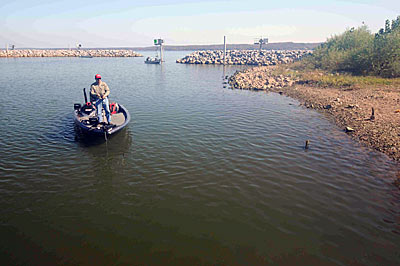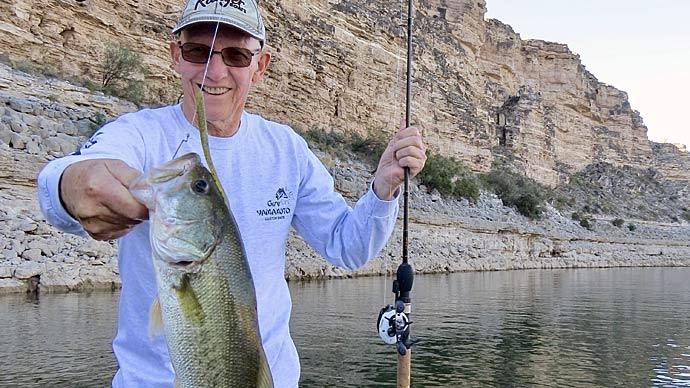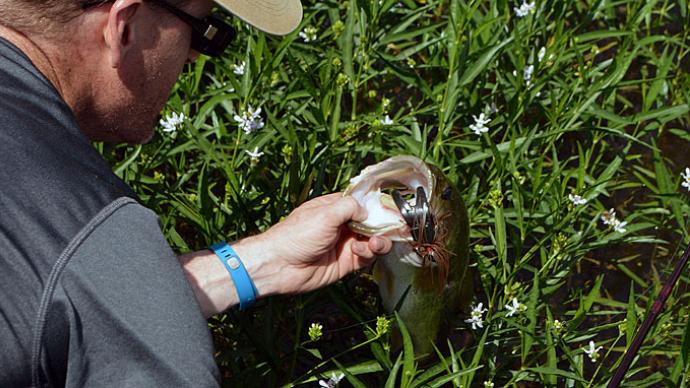
Bass anglers now have high-tech rods, reels, and super strong lines to increase their odds of landing a hooked fish. Despite this advanced gear, one age-old practice could result in a lost fish if done incorrectly.
“When you tie a knot in (your fishing line), it makes that the weakest point in the line,” Bassmaster Elite Series pro Shaw Grigsby says.
The Florida pro believes tying a “really good” knot is crucial in bass fishing. “You want to spend some time tying knots and testing them, and don’t just assume that a Palomar or an improved clinch knot is the best knot out there,” he says. “Tie the best knot you can.”
Grigsby tests various knots by taking a 3-foot section of line and tying a jig with a specific knot on one end of the line and tying a jig with a different knot on the other end. Then he pulls both jigs with pliers until the line or knot breaks to determine which knot is strongest. He conducts multiple tests to affirm the strongest of the two knots.
When new lines are introduced, Grigsby experiments with knots to see which holds best on the new lines. “Every line has a different knot that works the best for it,” Grigsby says.
His favorite knot for fluorocarbon line is one he calls a Double Pitzen. "It is a tremendous knot,” he says. “You can tie it single, but tying it (doubling your line) gives you that extra strength.”
Here are the steps for tying the Double Pitzen:
- Double your line and pass it through the eye of the hook.
- Pull the tag line towards the main line to form a circle.
- Wrap the tag line three times through the circle and pass it through the small loop held by your finger.
- Cinch the knot down and cut the three tag ends.
Grigsby ties his lures to monofilament with the Palomar knot, which he says “works great” for him.

The basic steps for the Palomar are the following:
- Double your line and pass it through the eye of the hook.
- Tie an overhand loop with the tag and main lines.
- While holding the overhand knot, pass the loop of line over the hook and slide the loop above the eye of the hook.
- Pull on both the main line and tag end to tighten the knot down onto the eye. Clip tag end.
A seven-turn double uni-knot is Grigsby’s favorite for tying onto braid. “Once you learn to tie it and cinch it down nicely, it is just tougher than tough,” he says.
Here are the steps for Grigsby’s double uni-knot.
- Double your line, run through the hook eye, and double back the tag line parallel to the main line.
- Make a loop by laying the tag end over the doubled main line.
- Make seven turns with the tag line around the doubled line and through the loop.
- Pull the tag end to snug the knot.
For tying a main line of braid with a fluorocarbon leader, Grigsby ties a knot shown to him by saltwater angler Dave Justice called the J Knot. He connects the fluorocarbon to the braid with a four-turn uni-knot and then wraps the braid around the fluorocarbon with a 12-turn improved clinch knot. “That is like a hand grabbing your fluorocarbon, so it kind of digs into the fluorocarbon and holds it like a grip,” Grigsby says. “With 12 turns (on the improved clinch knot), it has a massive grip on it.”
The only single line knot Grigsby ties is the King Sling to make a loop knot. “It makes a tremendous loop knot for topwaters and anything else you need to create action,” Grigsby says.
The steps for the King Sling are as follows:
- Insert the tag end of the line through the lure line tie, so it extends 8 to 10 inches.
- Hold the tag and main lines in your hand and form a loop.
- With the lure in your other hand, make three turns around the tag end and main line above the loop.
- Bring the lure down through the hoop to about the lure’s line tie.
- Tighten the knot by holding the line and pulling the tag end and main line simultaneously to create a 1/4-inch loop in the line. Trim the tag end.
Grigsby always moistens his monofilament and fluorocarbon line before cinching his knots but leaves his braid line dry. He also ties a half-hitch knot on the tag end of his line to prevent the tag from snagging on weeds and cuts his tag end about 1/8-inch from the knot.
Videos of Grigsby tying the knots mentioned above and others are available on youtube.com.




